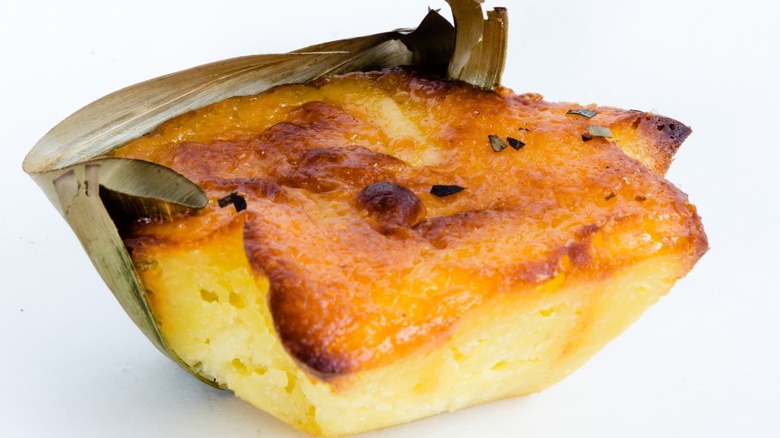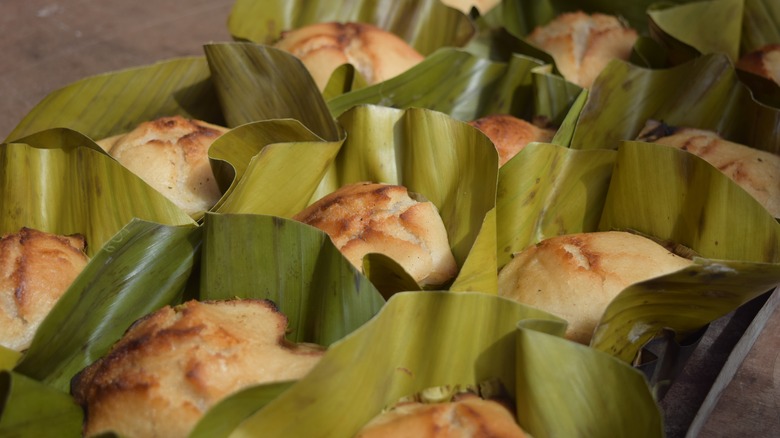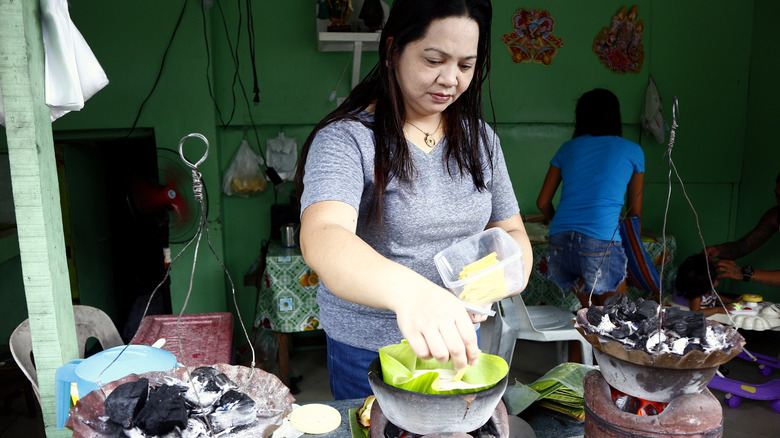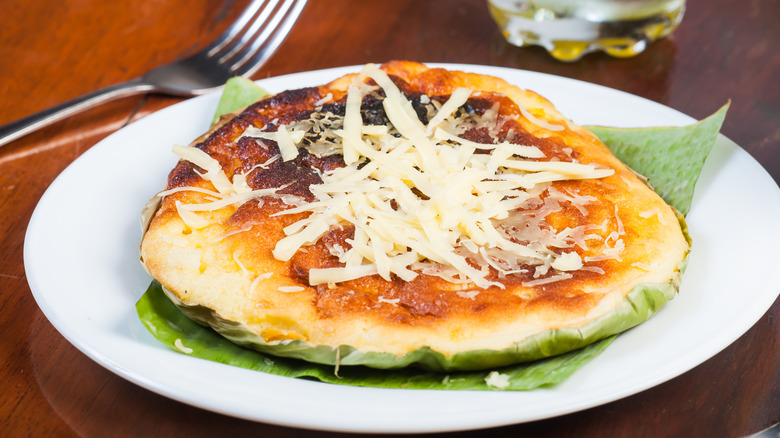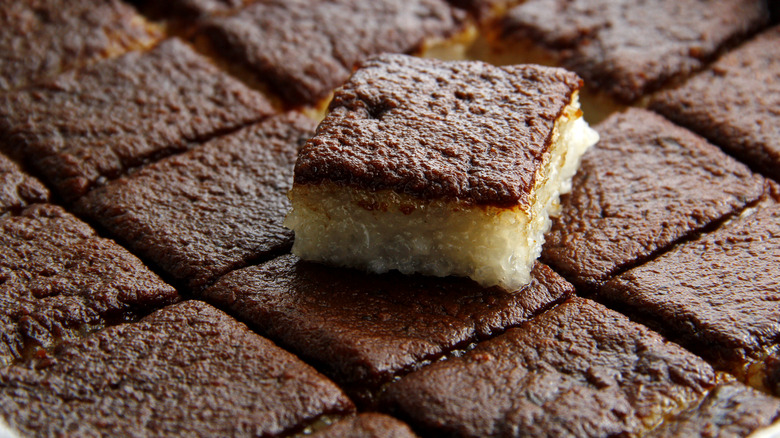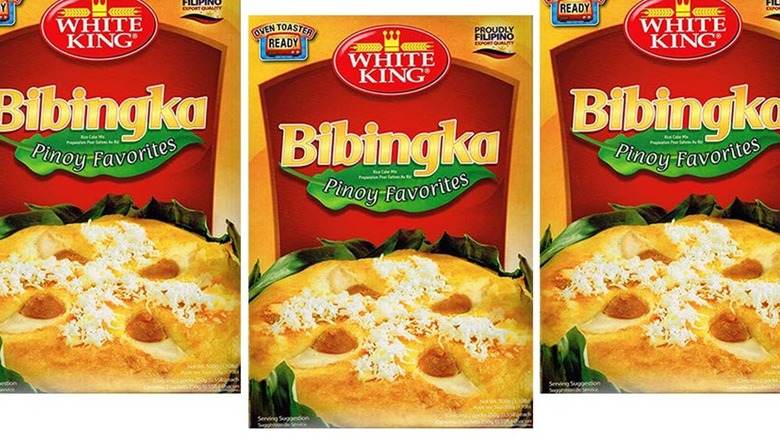What Is Bibingka And What Does It Taste Like?
We may receive a commission on purchases made from links.
How many foods are so beloved that they actually have a song named after them? Well, quite a lot, actually, but how about if you narrow it down to just holiday music? Well, in that case, there's, uh, the Wassail Song, maybe, although the drink that it celebrates is some old-timey thing that's long since been supplanted by eggnog and peppermint mochas. In the Philippines, though, it just wouldn't be Christmas without "Bibingka" — either the Ben&Ben song or the eponymous cake that it celebrates.
While we can only get an imperfect understanding of the song through a translation of the original Tagalog lyrics, it seems to suggest that this traditional rice flour cake is the best holiday gift you can buy for your true love, and we've got to admit it sounds far more appealing than having to deal with dozens of drumming drummers, gaggles of geese, and topiary-ensconced poultry. As in the song, these cakes are traditionally sold by street vendors outside the churches where las Misas de Gallo ("masses of the rooster," referring to the early morning hour at which the services take place) are held over the nine days leading up to Christmas, and the scent of freshly-baked bibingka may be just as evocative for Filipinos as chestnuts roasting over an open fire were for Mel Tormé.
History of bibingka
Bibingka falls under the general heading of kakanin, meaning cakes made from rice. There is a record of the Palawanese ruler (Palawan comprises several of the islands that today make up the Philippines archipelago) gifting arriving Spaniards with several types of kakanin back in the 16th century. However, bibingka didn't get called out by name (albeit with a slightly different spelling, with a "c" in place of the "gk") until 1751 when it was mentioned by a priest named Juan Delgado. He mentioned it as a breakfast dish that would be eaten accompanied by hot chocolate, which is still the case nearly 300 years later. (Okay, 270-some, but who's counting?)
Traditional bibingka recipes got a makeover in the early 20th century, as school home economics programs adopted the dish. The idea was to help document and preserve dishes native to the Philippines while at the same time making them more nutritious and also more standardized as to measurements, ingredients, etc. As these programs were established during a time when the U.S. exercised colonial rule in the Philippines, part of the process also involved Americanizing the recipes to some extent, at least as far as using ingredients that were more familiar to the expat colonists.
How bibingka is made
The traditional method of making bibingka can be pretty labor-intensive and time-consuming. It starts by making the rice dough called galapong, which in itself requires soaking the rice overnight. The mushy rice is then ground up (in a stone mill, if you want to be old-fashioned, or a food processor if not) to make the dough. Back in the olden days, it was often left to ferment and be flavored with wild yeast. The dough may then be mixed with other ingredients such as water, coconut milk, sugar, and eggs before being baked in a clay pot lined with banana leaves. Coals or dried coconut husks are piled below and atop the pot and burned, thus transforming the pot into an all-in-one cooking pot-slash-oven combo.
Modern home cooks, however, may wish to avoid the fire hazard inherent in such a cooking method by baking their bibingkas in a gas or electric oven, instead. They can also opt to use rice flour to make the galapong rather than grinding their own grain, while muffin pans might take the place of clay pots. A bit of banana leaf in each cup still helps to add flavor as well as make a pretty, old-school package, but in the absence of these leaves, parchment paper makes a passable substitute.
What bibingka tastes like
The main ingredient in bibingka, rice, is known for not having much flavor of its own, so the flavor of bibingka itself will tend to vary depending on what other ingredients are used. If the galapong is mixed with water alone to make the bibingka, the cake will be plainer than one made with coconut milk as the latter may taste, well, coconutty. The cake itself tends to be somewhat, but not overly, sweet and if cooked in the traditional way, may have a certain smoky char from the banana leaves.
Bibingka, in many cases, may owe much of its flavor to mix-ins. One popular addition to the standard bibingka recipe is salted duck eggs, a topping that makes the cakes taste (as you've no doubt guessed) somewhat salty. And also eggy. Bibingka may also be made with cheese, which of course makes it taste cheesy. In some areas of the Philippines, including the province of Cebu in the Central Visayas region, the palm wine known as tubâ (or the unfermented version called lina) can be added to the bibingka batter. This ingredient lends a somewhat sour and yeasty flavor to the finished cakes that sourdough fans may enjoy.
Bibingka variations
The standard kind of bibingka is more formally known as bibingka galapong and at its simplest consists of nothing more than galapong (rice dough, as you may remember from above) mixed with water. Moreover, coconut milk, eggs, butter, baking powder, or yeast are all typical of contemporary recipes. Bibingka malagkit, also known as biko, is made with the addition of glutinous rice flour and is topped with caramelized coconut cream, as is bibingka pinipig. Royal bibingka, which hails from the city of Vigan in Ilocos Sur province, also includes glutinous rice flour as well as evaporated milk but it has a savory topping made from melted cheese.
Bibingkang lalaki, bibingkang mandaue, and salukara are all made with tubâ a the primary leavening agent, although the latter don't need to rise much as they are cooked in a pan and are flatter and more pancake-like than most bibingka. Ilonggo or balasan-style bibingka is also on the flat side and is enhanced with fresh coconut, while durian bibingka is, surprise, made with durian. Bibingkang kamoteng kahoy, however, is a real outlier as it isn't made with rice at all. Instead, it's made from cassava flour and usually has a milk-cheese topping. Another type of cassava-based bibingka, however, is said to include pineapple or buko (green coconut).
Where to buy bibingka
The best place to buy bibingka is, of course, just like the song says: Outside a church as a well-deserved treat after getting up in the pre-dawn hours to attend mass. Don't forget to buy one for your sweetie or, if single, show some self-love by buying two to eat by yourself. You can also acquire bibingka in more secular establishments such as the Eut Cafe in Batasan or Cafe Laguna, a mini-chain with locations in Cebu and General Santos.
Here in the United States, you may be able to track down bibingka at a Filipino bakery or restaurant such as Goldilocks, another mini-chain with a handful of stores throughout California and one in Nevada. Several enterprising home bakers also sell bibingka on Etsy, while Amazon offers several types of bibingka mix if you'd like to try making it yourself. While these mixes may not include banana leaves in which to wrap the bibingka, of course, you can buy these on Amazon, as well.
